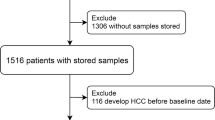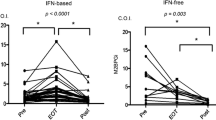Abstract
Background
Hepatocellular carcinoma (HCC) occurs in chronic hepatitis B (CH-B) patients even after treatment with nucleos(t)ide analogues (NAs) by a mechanism involving an association between the oncogenic factors of integrated HBV and liver fibrosis. An association has been demonstrated between advanced chronic liver disease and elevated levels of Wisteria floribunda agglutinin-positive Mac-2 binding protein (WFA(+)-M2BP), a recently discovered serum liver fibrosis marker. Moreover, hepatitis B core-related antigen (HBcrAg) reflects intracellular HBV protein production and its relationship with liver carcinogenesis has been reported. This study aimed to determine whether the incidence and recurrence of HBV-related liver cancer could be predicted using these serum markers.
Methods
We evaluated 141 CH-B cases treated for more than 1 year with NAs. We compared 17 HCC cases with 124 non-HCC cases and evaluated serum WFA(+)-M2BP, HBV markers including HBcrAg, and other clinical factors. We also evaluated 71 CH-B-related HCC cases who started or continued NAs and compared the incidence and recurrence of HCC after successful cancer treatment.
Results
Multivariate analysis showed that the incidence of HCC was significantly associated with higher histological stage and grade before NA treatment and with WFA(+)-M2BP and HBcrAg positivity during NA treatment. The cumulative incidence of HCC was strongly associated with higher WFA(+)-M2BP levels and HBcrAg positivity. HCC recurrence after anti-cancer therapy was also significantly associated with higher WFA(+)-M2BP levels compared with those in cases without recurrence during follow-up.
Conclusion
Serum WFA(+)-M2BP and HBcrAg are useful diagnostic tests for predicting the development and recurrence of HBV-related HCC during NA treatment.




Similar content being viewed by others
Abbreviations
- WFA(+)-M2BP:
-
Wisteria floribunda agglutinin-positive Mac-2 binding protein
- M2BPGi:
-
Mac-2 binding protein glycosylation isomer
- NA(s):
-
Nucleos(t)ide analogue(s)
- HBcrAg:
-
HBV core-related antigen
References
Fu C, Liu N, Deng Q, et al. Radiofrequency ablation vs. surgical resection on the treatment of patients with small hepatocellular carcinoma: a system review and meta-analysis of five randomized controlled trials. Hepatogastroenterology. 2014;61:1722–9.
Guo W, He X, Li Z, Li Y. Combination of transarterial chemoembolization (TACE) and radiofrequency ablation (RFA) vs. surgical resection (SR) on survival outcome of early hepatocellular carcinoma: a meta-analysis. Hepatogastroenterology. 2015;62:710–4.
Hiramatsu N, Yamada R, Takehara T. The suppressive effect of nucleos(t)ide analogue treatment on the incidence of hepatocellular carcinoma in chronic hepatitis B patients. J Gastroenterol Hepatol. 2016;31:546–52.
Ishikawa T. Anti-viral therapy to reduce recurrence and improve survival in hepatitis B virus-related hepatocellular carcinoma. World J Gastroenterol. 2013;19:8861–6.
Wang Q, Zhang T, Ye L, et al. Analysis of hepatitis B virus X gene (HBx) mutants in tissues of patients suffered from hepatocellular carcinoma in China. Cancer Epidemiol. 2012;36:369–74.
Suh B, Park S, Shin DW, et al. High liver fibrosis index FIB-4 is highly predictive of hepatocellular carcinoma in chronic hepatitis B carriers. Hepatology. 2015;61:1261–8.
Kuno A, Ikehara Y, Tanaka Y, et al. A serum “sweet-doughnut” protein facilitates fibrosis evaluation and therapy assessment in patients with viral hepatitis. Sci Rep. 2013;3:1065.
Yamasaki K, Tateyama M, Abiru S, et al. Elevated serum levels of Wisteria floribunda agglutinin-positive human Mac-2 binding protein predict the development of hepatocellular carcinoma in hepatitis C patients. Hepatology. 2014;60:1563–70.
Umemura T, Joshita S, Sekiguchi T, et al. Serum Wisteria floribunda agglutinin-positive Mac-2-binding protein level predicts liver fibrosis and prognosis in primary biliary cirrhosis. Am J Gastroenterol. 2015;110:857–64.
Toshima T, Shirabe K, Ikegami T, et al. A novel serum marker, glycosylated Wisteria floribunda agglutinin-positive Mac-2 binding protein (WFA(+)-M2BP), for assessing liver fibrosis. J Gastroenterol. 2015;50:76–84.
Nishikawa H, Enomoto H, Iwata Y, et al. Clinical significance of serum Wisteria floribunda agglutinin positive Mac-2-binding protein level and high-sensitivity C-reactive protein concentration in autoimmune hepatitis. Hepatol Res. 2016;46:613–21.
Nishikawa H, Enomoto H, Iwata Y, et al. Clinical significance of serum Wisteria floribunda agglutinin-positive Mac-2-binding protein level in non-alcoholic steatohepatitis. Hepatol Res. 2016;46:1194–202.
Abe M, Miyake T, Kuno A, et al. Association between Wisteria floribunda agglutinin-positive Mac-2 binding protein and the fibrosis stage of non-alcoholic fatty liver disease. J Gastroenterol. 2015;50:776–84.
Fujiyoshi M, Kuno A, Gotoh M, et al. Clinicopathological characteristics and diagnostic performance of Wisteria floribunda agglutinin positive Mac-2-binding protein as a preoperative serum marker of liver fibrosis in hepatocellular carcinoma. J Gastroenterol. 2015;50:1134–44.
Sasaki R, Yamasaki K, Abiru S, et al. Serum Wisteria floribunda agglutinin-positive Mac-2 binding protein values predict the development of hepatocellular carcinoma among patients with chronic hepatitis C after sustained virological response. PLoS One. 2015;10:e0129053.
Nishikawa H, Enomoto H, Iwata Y, et al. Clinical implication of serum WFA+-M2BP level on hepatitis B e antigen loss or seroconversion in hepatitis B e antigen-positive patients. Hepatol Res. 2016;46:1065–73.
Zhou D, Wang Y, Zhang W, et al. WFA(+) -M2BP: a novel biomarker with diagnostic and therapeutic implications in liver diseases. Liver Int. 2016;36:612.
Ishii A, Nishikawa H, Enomoto H, et al. Clinical implication of serum Wisteria floribunda agglutinin-positive Mac-2-binding protein in treatment naïve chronic hepatitis B. Hepatol Res. 2017;47:204–15.
Zou X, Zhu MY, Yu DM, et al. Serum WFA(+) -M2BP levels for evaluation of early stages of liver fibrosis in patients with chronic hepatitis B virus infection. Liver Int. 2017;37:35–44.
Kim SU, Heo JY, Kim BK, et al. Wisteria floribunda agglutinin-positive human Mac-2 binding protein predicts the risk of HBV-related liver cancer development. Liver Int. 2017;37:879–87.
Heo JY, Kim SU, Kim BK, et al. Use of Wisteria floribunda agglutinin-positive human Mac-2 binding protein in assessing risk of hepatocellular carcinoma due to hepatitis B virus. Medicine (Baltimore). 2016;95:e3328.
Kimura T, Rokuhara A, Sakamoto Y, et al. Sensitive enzyme immunoassay for hepatitis B virus core-related antigens and their correlation to virus load. J Clin Microbiol. 2002;40:439–45.
Rokuhara A, Tanaka E, Matsumoto A, et al. Clinical evaluation of a new enzyme immunoassay for hepatitis B virus core-related antigen; a marker distinct from viral DNA for monitoring lamivudine treatment. J Viral Hepat. 2003;10:324–30.
Shinkai N, Tanaka Y, Orito E, et al. Measurement of hepatitis B virus core-related antigen as predicting factor for relapse after cessation of lamivudine therapy for chronic hepatitis B virus infection. Hepatol Res. 2006;36:272–6.
Matsumoto A, Tanaka E, Minami M, et al. Low serum level of hepatitis B core-related antigen indicates unlikely reactivation of hepatitis after cessation of lamivudine therapy. Hepatol Res. 2007;37:661–6.
Kimura T, Ohno N, Terada N, et al. Hepatitis B virus DNA-negative dane particles lack core protein but contain a 22-kDa precore protein without C-terminal arginine-rich domain. J Biol Chem. 2005;280:21713–9.
Honda M, Shirasaki T, Terashima T, et al. Hepatitis B virus (HBV) core-related antigen during nucleos(t)ide analog therapy is related to intra-hepatic HBV replication and development of hepatocellular carcinoma. J Infect Dis. 2016;213:1096–106.
Vallet-Pichard A, Mallet V, Nalpas B, et al. FIB-4: an inexpensive and accurate marker of fibrosis in HCV infection. comparison with liver biopsy and fibrotest. Hepatology. 2007;46:32–6.
Menéndez-Arias L, Álvarez M, Pacheco B. Nucleoside/nucleotide analog inhibitors of hepatitis B virus polymerase: mechanism of action and resistance. Curr Opin Virol. 2014;8:1–9.
Xia BW, Zhang YC, Wang J, et al. Efficacy of antiviral therapy with nucleotide/nucleoside analogs after curative treatment for patients with hepatitis B virus-related hepatocellular carcinoma: a systematic review and meta-analysis. Clin Res Hepatol Gastroenterol. 2015;39:458–68.
Triolo M, Della Corte C, Colombo M. Impact of HBV therapy on the incidence of hepatocellular carcinoma. Liver Int. 2014;34(1):139–45.
Kuno A, Sato T, Shimazaki H, et al. Reconstruction of a robust glycodiagnostic agent supported by multiple lectin-assisted glycan profiling. Proteomics Clin Appl. 2013;7:642–7.
Matsuda A, Kuno A, Kawamoto T, et al. Wisteria floribunda agglutinin-positive mucin 1 is a sensitive biliary marker for human cholangiocarcinoma. Hepatology. 2010;52:174–82.
Zhang XD, Wang Y, Ye LH. Hepatitis B virus X protein accelerates the development of hepatoma. Cancer Biol Med. 2014;11:182–90.
Acknowledgements
The authors thank Nami Nishiyama for management of the serum samples.
Author information
Authors and Affiliations
Corresponding author
Ethics declarations
Conflict of interest
None of the material in this manuscript has been or will be published and none is currently under consideration for publication elsewhere, and that the conflict of interest disclosure statement on the ScholarOne manuscript was completed at the time of submission.
Electronic supplementary material
Below is the link to the electronic supplementary material.
Rights and permissions
About this article
Cite this article
Kawaguchi, K., Honda, M., Ohta, H. et al. Serum Wisteria floribunda agglutinin-positive Mac-2 binding protein predicts hepatocellular carcinoma incidence and recurrence in nucleos(t)ide analogue therapy for chronic hepatitis B. J Gastroenterol 53, 740–751 (2018). https://doi.org/10.1007/s00535-017-1386-2
Received:
Accepted:
Published:
Issue Date:
DOI: https://doi.org/10.1007/s00535-017-1386-2




